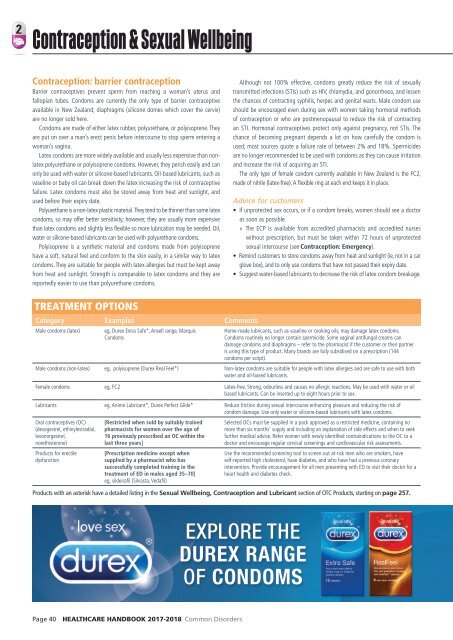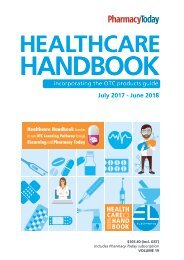2017 HCHB_digital
You also want an ePaper? Increase the reach of your titles
YUMPU automatically turns print PDFs into web optimized ePapers that Google loves.
Contraception & Sexual Wellbeing<br />
Contraception: barrier contraception<br />
Barrier contraceptives prevent sperm from reaching a woman’s uterus and<br />
fallopian tubes. Condoms are currently the only type of barrier contraceptive<br />
available in New Zealand; diaphragms (silicone domes which cover the cervix)<br />
are no longer sold here.<br />
Condoms are made of either latex rubber, polyurethane, or polyisoprene. They<br />
are put on over a man’s erect penis before intercourse to stop sperm entering a<br />
woman’s vagina.<br />
Latex condoms are more widely available and usually less expensive than nonlatex<br />
polyurethane or polyisoprene condoms. However, they perish easily and can<br />
only be used with water or silicone-based lubricants. Oil-based lubricants, such as<br />
vaseline or baby oil can break down the latex increasing the risk of contraceptive<br />
failure. Latex condoms must also be stored away from heat and sunlight, and<br />
used before their expiry date.<br />
Polyurethane is a non-latex plastic material. They tend to be thinner than some latex<br />
condoms, so may offer better sensitivity; however, they are usually more expensive<br />
than latex condoms and slightly less flexible so more lubrication may be needed. Oil,<br />
water or silicone-based lubricants can be used with polyurethane condoms.<br />
Polyisoprene is a synthetic material and condoms made from polyisoprene<br />
have a soft, natural feel and conform to the skin easily, in a similar way to latex<br />
condoms. They are suitable for people with latex allergies but must be kept away<br />
from heat and sunlight. Strength is comparable to latex condoms and they are<br />
reportedly easier to use than polyurethane condoms.<br />
Although not 100% effective, condoms greatly reduce the risk of sexually<br />
transmitted infections (STIs) such as HIV, chlamydia, and gonorrhoea, and lessen<br />
the chances of contracting syphilis, herpes and genital warts. Male condom use<br />
should be encouraged even during sex with women taking hormonal methods<br />
of contraception or who are postmenopausal to reduce the risk of contracting<br />
an STI. Hormonal contraceptives protect only against pregnancy, not STIs. The<br />
chance of becoming pregnant depends a lot on how carefully the condom is<br />
used; most sources quote a failure rate of between 2% and 18%. Spermicides<br />
are no longer recommended to be used with condoms as they can cause irritation<br />
and increase the risk of acquiring an STI.<br />
The only type of female condom currently available in New Zealand is the FC2,<br />
made of nitrile (latex-free). A flexible ring at each end keeps it in place.<br />
Advice for customers<br />
• If unprotected sex occurs, or if a condom breaks, women should see a doctor<br />
as soon as possible.<br />
»»<br />
The ECP is available from accredited pharmacists and accredited nurses<br />
without prescription, but must be taken within 72 hours of unprotected<br />
sexual intercourse (see Contraception: Emergency).<br />
• Remind customers to store condoms away from heat and sunlight (ie, not in a car<br />
glove box), and to only use condoms that have not passed their expiry date.<br />
• Suggest water-based lubricants to decrease the risk of latex condom breakage.<br />
TREATMENT OPTIONS<br />
Category Examples Comments<br />
Male condoms (latex)<br />
eg, Durex Extra Safe*, Ansell range, Marquis<br />
Condoms<br />
Home-made lubricants, such as vaseline or cooking oils, may damage latex condoms.<br />
Condoms routinely no longer contain spermicide. Some vaginal antifungal creams can<br />
damage condoms and diaphragms – refer to the pharmacist if the customer or their partner<br />
is using this type of product. Many brands are fully subsidised on a prescription (144<br />
condoms per script).<br />
Male condoms (non-latex) eg, polyisoprene (Durex Real Feel*) Non-latex condoms are suitable for people with latex allergies and are safe to use with both<br />
water and oil-based lubricants.<br />
Female condoms eg, FC2 Latex-free. Strong, odourless and causes no allergic reactions. May be used with water or oil<br />
based lubricants. Can be inserted up to eight hours prior to sex.<br />
Lubricants eg, Anime Lubricant*, Durex Perfect Glide* Reduce friction during sexual intercourse enhancing pleasure and reducing the risk of<br />
condom damage. Use only water or silicone-based lubricants with latex condoms.<br />
Oral contraceptives (OC)<br />
(desogestrel, ethinylestradiol,<br />
levonorgestrel,<br />
norethisterone)<br />
Products for erectile<br />
dysfunction<br />
[Restricted when sold by suitably trained<br />
pharmacists for women over the age of<br />
16 previously prescribed an OC within the<br />
last three years]<br />
[Prescription medicine except when<br />
supplied by a pharmacist who has<br />
successfully completed training in the<br />
treatment of ED in males aged 35–70]<br />
eg, sildenafil (Silvasta, Vedafil)<br />
Selected OCs must be supplied in a pack approved as a restricted medicine, containing no<br />
more than six months' supply and including an explanation of side effects and when to seek<br />
further medical advice. Refer women with newly identified contraindications to the OC to a<br />
doctor and encourage regular cervical screenings and cardiovascular risk assessments.<br />
Use the recommended screening tool to screen out at-risk men who are smokers, have<br />
self-reported high cholesterol, have diabetes, and who have had a previous coronary<br />
intervention. Provide encouragement for all men presenting with ED to visit their doctor for a<br />
heart health and diabetes check.<br />
Products with an asterisk have a detailed listing in the Sexual Wellbeing, Contraception and Lubricant section of OTC Products, starting on page 257.<br />
EXPLORE THE<br />
DUREX RANGE<br />
OF CONDOMS<br />
Page 40 HEALTHCARE HANDBOOK <strong>2017</strong>-2018 Common Disorders



